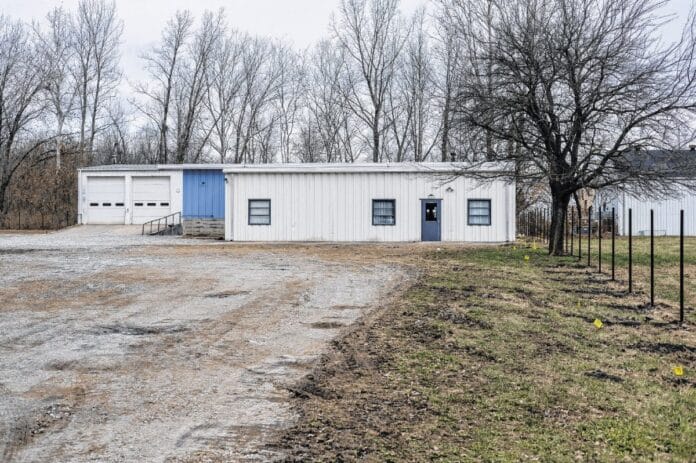
State-led efforts to clean up an environmentally-contaminated property that the Columbus Parks Board purchased from Mayor Jim Lienhoop’s aunt are continuing after recent soil samples revealed two new contaminants on the site.
Tests completed in November found concentrations of suspected cancer-causing compounds benzo(a)pyrene and dibenz(a,h)anthracene in soil removed from the former Machinery Moving Inc. facility, 1360 Jackson St.
The amounts “slightly” exceeded state residential screening levels, according to a report by Heartland Environmental Associates Inc., a contractor hired by the Indiana Finance Authority’s Brownfields Program to oversee the property remediation.
While environmental testing over the past year has detected several contaminants that experts believe were likely caused by leaking underground fuel storage tanks installed on the site in the 1970s, the newly detected compounds are thought to have come from another source, said Stephanie McFarland, spokeswoman for the Indiana Finance Authority’s Brownfields Program. The results, however, did not exceed state thresholds for commercial and industrial screening levels.
[sc:text-divider text-divider-title=”Story continues below gallery” ]
“These two new contaminants are suspected to be related to a fill layer of refinery (foundry) sand that may have been placed on the site,” she said.
The property, which the parks board agreed to purchase from Norma Lienhoop in July in six annual installments of $34,166.67, or a $205,000, was sought by the Columbus Parks and Recreation Department for at least the past 15 months in hopes of using two vacant single-story buildings on the site for storage.
Lienhoop recused himself from all negotiations and decisions about the building and has referred all questions about the transaction to parks officials.
In January, city officials temporarily halted plans to acquire the site after environmental testing revealed several petroleum hydrocarbon constituents above state thresholds on the property. City officials, who were adamant that no city tax dollars would be used to remediate the property, later determined that an initiative from the Indiana Brownfields Program could bankroll the clean up.
The initiative, called Petroleum Orphan Sites Initiative, or POSI, seeks to help communities across the state address petroleum contamination caused by leaking underground storage tanks that “cannot be addressed by the party responsible for cleanup as a result of an inability-to-pay, bankruptcy or other factors,” according to the program’s website.
The Indiana Brownfields Program is a statewide program that assists in the redevelopment of brownfield properties. The U.S. Environmental Protection Agency defines a brownfield as a “property, the expansion, redevelopment or reuse of which may be complicated by the presence or potential presence of a hazardous substance, pollutant or contaminant.”
As of October, there were at least 25 brownfield sites in Bartholomew County, according to the Indiana Department of Environmental Management.
The initiative receives funding from IDEM’s Excess Liability Trust Fund, which is funded by an “inspection fee” that the Indiana Department of Revenue levies on every barrel of fuel, said Barry Sneed, IDEM spokesman.
“That tax is then passed down to the consumer in the form of a $0.01 per gallon gas tax,” Sneed said in a previous interview.
The Jackson Street property was officially accepted into the program on Sept. 9, McFarland said. So far, the Indiana Brownfields Program has paid Heartland Environmental Associates Inc. $129,645 to remediate the site. An additional $7,694 related to soil removal work is under review.
The currently approved budget for remediation of the Jackson Street property is $183,763, and the project is expected to take two years, McFarland said. State officials previously said the property was eligible for the POSI program because it was not viable for the former Machinery Moving Inc. to clean up the property because the company had been “sold twice since the time it operated on the site.”
Mark Jones, Columbus Parks and Recreation director, said he is “not concerned” about whether the newly-detected compounds indicate greater-than-anticipated environmental contamination on the site.
“(Indiana Brownfields Program officials) feel confident in the work that has been done,” he said.
Discarded tires, buried refuse
Heartland Environmental Associates officials reported in November that they oversaw the excavation, removal and disposal of 1,872.86 tons of soil from the property from Oct. 28 to Oct. 31, according to the report, which was filed with the state in November and published online Dec. 5.
During excavation, workers dug down to a depth of 14 feet and found discarded tires, automotive parts, brick, concrete, crushed cinder and “black foundry sand” as deep as 10 feet below the surface of the property, the report states. Workers then took 12 soil samples from the excavation pit.
Foundry sand is often used by metal casting companies to make molds, according to the U.S. Environmental Protection Agency. Typically, the sand can be reused, but eventually needs to be discarded. The American Foundry Society estimates that around 6 to 10 million tons of foundry sand is discarded in the United States each year.
There is no explanation in the report for how foundry sand ended up 10 feet below the surface of the property. Machinery Moving operations on the site included transportation and storage of various types of machinery, but the company ceased operations on the site in early 2018, according to Indianapolis-based Ark Engineering Services, a contractor hired by the city.
In the past, the firm would pick up big equipment for large manufacturing companies, such as Cummins and Arvin, and move it to different factory sites, according to city officials.
Ark said in its report that the company historically operated at least three underground tanks, including one with capacity for 2,000 gallons of gasoline, one with a capacity of 1,000 gallons of diesel fuel and another for 550 gallons of diesel fuel.
On Oct. 31 and Nov. 1, the excavation pit was filled with 1,546 tons of sand and 137 tons of crush gravel, the Heartland report states. The rest of the soil was taken to the Bartholomew County Landfill for disposal. The samples were processed last month at a Pace Analytical Services Inc. location in Indianapolis, according to the Heartland report.
Previous tests had shown chemical impacts from several petroleum hydrocarbon constituents, including benzene, ethylbenzene, 1,2,4-trimethylbenzene, 1,3,5-trimethylbenzene, xylenes, 1-methylnaphthalene, 2-methylnaphthalene and naphthalene, according to Ark.
State officials are planning to take groundwater samples to determine if further remediation is needed, McFarland said.
“Groundwater assessment is the next phase of work to be completed and sampling well installation is anticipated in January, weather permitting,” she said. “Contaminant concentrations, if any, following monitoring well installation and initial groundwater sampling will determine whether groundwater remediation is needed. At most, the program expects eight quarters of groundwater monitoring before closing the project.”
Jones estimates the department will save about $47,000 annually with the Jackson Street buildings, which Jones said parks officials have already started using to store “small items.”
Previously, crews traveled to the department’s storage unit on the north side of town in the Columbus Air Park about five times a day to retrieve parts and supplies. The $47,000 savings accounts for labor, equipment and gasoline costs, he said.
“There will probably be a couple years of monitoring wells, but we anticipated that from the beginning,” Jones said. “…Everything is going as planned.”
[sc:pullout-title pullout-title=”Indiana Brownfields Program” ][sc:pullout-text-begin]
The Indiana Finance Authority’s Brownfields Program is a statewide program that assists in the redevelopment of brownfield properties. The U.S. Environmental Protection Agency defines a brownfield as a “property, the expansion, redevelopment or reuse of which may be complicated by the presence or potential presence of a hazardous substance, pollutant or contaminant.”
As of October, there were at least 25 brownfield sites in Bartholomew County, according to the Indiana Department of Environmental Management.
For more information about the program, visit in.gov/ifa/brownfields/index.htm.
[sc:pullout-text-end][sc:pullout-title pullout-title=”About the new contaminants” ][sc:pullout-text-begin]
Exposure to benzo(a)pyrene in animals is associated with reproductive, developmental and immunological effects, as well as cancers of the liver, kidney and respiratory tract according to a toxicological review by the U.S. Environmental Protection Agency. The review states that human studies generally have shown similar results.
Dibenz(a,h)anthracene, a product of incomplete combustion of organic compounds, is "probably carcinogenic to humans," according to the National Institutes of Health’s National Library of Medicine.
[sc:pullout-text-end][sc:pullout-title pullout-title=”Read the report” ][sc:pullout-text-begin]
To view the most recent report about the Jackson Street property in Columbus, visit the Indiana Department of Environmental Management’s Virtual File Cabinet at vfc.idem.in.gov/DocumentSearch.aspx. Under alternate field, select "Document ID" and enter 82873668 in the corresponding space.
[sc:pullout-text-end]




